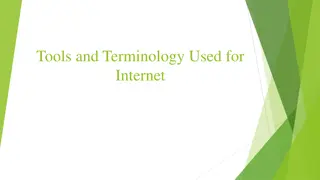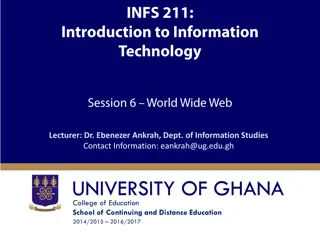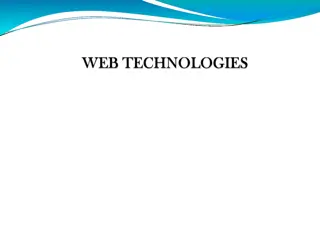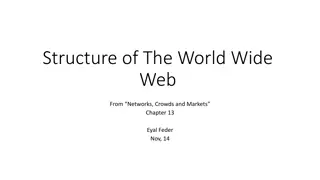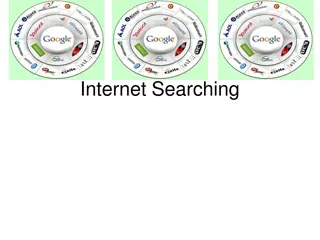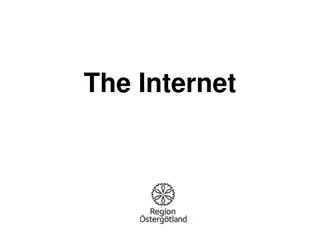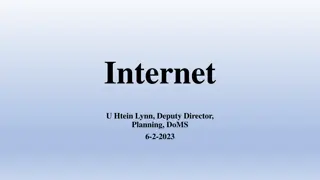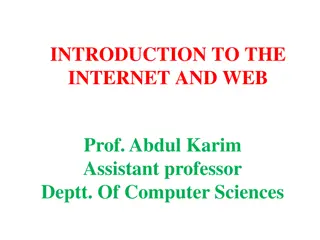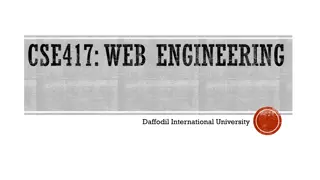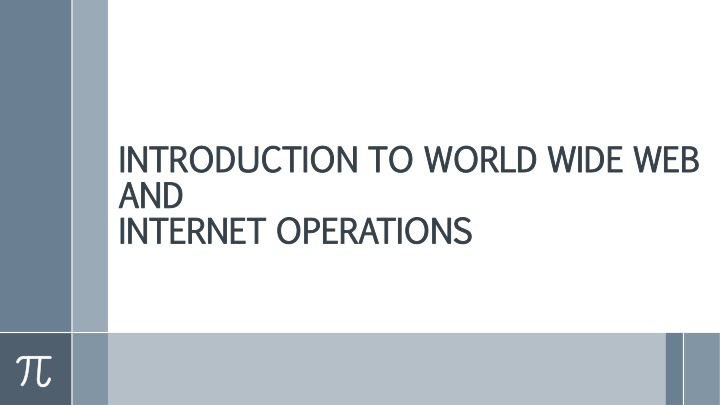
Introduction to World Wide Web and Internet Operations
The World Wide Web and the Internet are interconnected concepts revolutionizing information exchange and business operations. The Internet is a global network of interconnected computers using standardized protocols, while the World Wide Web allows access to hypertext documents and multimedia content. Key components include web pages, web browsers, and web servers. Understanding how the Internet and Web operate, including data transmission, request-response models, and hyperlinks, is essential in today's digital world.
Download Presentation

Please find below an Image/Link to download the presentation.
The content on the website is provided AS IS for your information and personal use only. It may not be sold, licensed, or shared on other websites without obtaining consent from the author. If you encounter any issues during the download, it is possible that the publisher has removed the file from their server.
You are allowed to download the files provided on this website for personal or commercial use, subject to the condition that they are used lawfully. All files are the property of their respective owners.
The content on the website is provided AS IS for your information and personal use only. It may not be sold, licensed, or shared on other websites without obtaining consent from the author.
E N D
Presentation Transcript
INTRODUCTION TO WORLD WIDE WEB INTRODUCTION TO WORLD WIDE WEB AND AND INTERNET OPERATIONS INTERNET OPERATIONS
The World interconnected concepts that have revolutionized the way individuals and organizations information, information, and and conduct conduct business business. . Understanding their operations is crucial in today s digital world. World Wide Wide Web Web (WWW) (WWW) and the Internet Internet are two communicate, communicate, share share
What is the Internet? What is the Internet? The Internet Internet is a global network of interconnected computers that communicate with one another using standardized protocols such as Transmission and Internet Internet Protocol Protocol (IP) (IP). It enables the transfer of data, resources, and services across the globe. Transmission Control Control Protocol Protocol (TCP) (TCP)
What is the World Wide Web (WWW)? What is the World Wide Web (WWW)? The World World Wide hypertext documents and multimedia content accessed via the Internet. It was developed by Tim Tim Berners Berners- -Lee Lee in 1989 and uses the Hypertext (HTTP) (HTTP) to transmit data. Wide Web Web, often simply referred to as "the Web," is a system of interlinked Hypertext Transfer Transfer Protocol Protocol
Key Components of the Web: Key Components of the Web: 1. Web pages: Documents formatted using Hypertext Markup Language (HTML). 2. Web browsers: Software like Google Chrome, Mozilla Firefox, and Safari used to access the web. 3. Web servers: Computers that store and deliver web pages upon request
How the Internet and Web Operate How the Internet and Web Operate 1. Data Transmission: Data is transferred in packets using TCP/IP protocols. Each packet carries a portion of the data along with its destination address. Example: Streaming a video involves sending multiple data packets between the server and your device. 2. Request-Response Model: When you enter a URL in a web browser, the following steps occur: I. The browser sends a request to a DNS server to resolve the domain name (e.g., www.google.com) into an IP address. II. The browser connects to the corresponding web server. III. The server sends back the requested web page or resource. 3. Hyperlinks and Navigation : Hyperlinks in web pages allow users to jump from one page to another seamlessly, enabling easy navigation across the vast web.
Key Features of Internet Operations Key Features of Internet Operations 1. Email: A widely used application for communication using protocols like SMTP (Simple Mail Transfer Protocol) and IMAP (Internet Message Access Protocol). Example: Gmail, Outlook. 2. File Sharing: Sharing files via services like FTP (File Transfer Protocol), cloud storage, or peer-to-peer networks. Example: Google Drive, Dropbox. 3. Search Engines: Tools like Google and Bing that index and retrieve relevant information based on user queries. 4. E-Commerce: Online platforms like Amazon and Flipkart enable businesses to sell products and services directly to consumers. 5. Social Networking: Platforms like Facebook and Instagram allow people to connect, share, and interact online.
Importance of the Internet and WWW Importance of the Internet and WWW 1. Global Connectivity: Enables instant communication and access to information worldwide. 2. Business Operations: Facilitates e-commerce, online marketing, and supply chain integration. 3. Education and Research: Provides a wealth of resources for learning and innovation. 4. Entertainment: Offers on-demand access to videos, music, games, and more.
Challenges and Issues Challenges and Issues 1. Cybersecurity Threats: Phishing, malware, and hacking can compromise user data and privacy. 2. Digital Divide: Not everyone has equal access to the Internet, creating disparities. 3. Bandwidth and Speed: High-quality operations require robust infrastructure, which may not be available in all regions
Emerging Trends in Internet Operations Emerging Trends in Internet Operations 1. Internet of Things (IoT): Devices interconnected via the Internet for smart operations. Example: Smart homes with automated lights and thermostats. 2. 5G Technology: Faster, more reliable Internet connectivity to support advanced applications. 3. Artificial Intelligence (AI): Enhances search engines, chatbots, and personalized recommendations. 4. Blockchain: Ensures secure transactions and data storage. 5. Machine Learning 6. Sensory Vision
Conclusion Conclusion The Internet and World Wide Web have become the backbone of modern communication, business, and personal life. With ongoing advancements, their operations will continue to shape how we interact with technology and the world around us. By understanding their fundamentals, individuals and organizations can harness their potential effectively.

